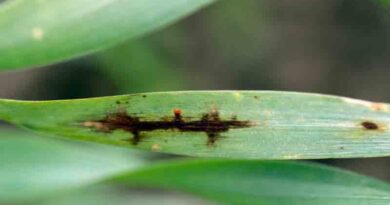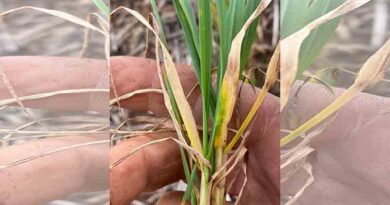Why Australian Farmers Should Be Assessing Sclerotinia Risk on a Paddock-By-Paddock Basis
21 July 2022, AU: The combination of a high priced canola market, and a wet, cool winter has led to the potential for severe Sclerotinia Stem Rot incidence in some areas. It is important to keep on top of your Sclerotnia management program, as under conducive conditions it can cause significant yield losses with reports of >20% when management is poor.
Assessment of sclerotinia risk is important by identifying the risk of sclerontia developing on a paddock-by-paddock basis. Sclerotinia can survive for up to six years in the soil. A good rule of thumb is that if a paddock or adjacent paddock has had an infection of sclerotinia in the last 3 years, you can assume the paddock is at high risk of developing the disease. Paddocks with a tight rotation are also at risk, meaning if a susceptible crop has been grown in the paddock in the last 2 years, you can assume the paddock is at high risk. Susceptible crops include canola, lupins, chickpeas, lentils, faba beans and field peas. Certain weeds such as brassicas (including wild radish) and capeweed can also be infected with the disease. The best tools for management of soil borne diseases are rotating and keeping crops as clean as possible.
As we are already well into the season, monitoring at risk paddocks will be key to managing a potential outbreak of the disease. During cool and damp conditions during autumn or winter, the sclerotina spores in the soil germinate to produce small mushroom shaped structures (called apothecia). This happens in temperatures between 10-22 deg C. The apothecia produce thousands of air borne spores, which can be carried significant distances on the wind. If apothecia have been identified in the paddock or anywhere on the property, your canola is at risk of developing the disease.
It is important to monitor conditions during flowering and implement a management strategy because these spores can infect the petals of the canola plant. Like most fungal diseases sclerotnia loves moist conditions, therefore moist conditions during flowering puts the crop at significant risk of developing sclerotinia. During this period of moisture during flowering, the infected petals fall into the canopy and stick to the leaf axils (the joint of the leaf and stem). The fungus then invades the healthy stem and causes the stem to bleach, rot and the plant subsequently lodges.
Timing of fungicides is important in preserving your yield and preventing a severe outbreak of the disease. Optimal timing is available on fungicide labels. However, it is always more beneficial to apply fungicides before or in the early stages of a disease outbreak. Teb Pro 420 is a fungicide which is registered for management of sclerotinia stem rot in canola. However, when making the decision to spray a few key determinants need to be taken into account.
Does the paddock present a risk of developing sclerotinia – either by rotation, presence of inoculum in or in nearby paddocks (or on neighbours farm)?
Crop growth stage
Favourable weather conditions – rainfall and humidity during and after flowering is critical for disease infection of both the petals, and the secondary infection of the stem.
Yield and gross margin potential – in years like this it is a bit easier to determine the need to spray, but a yield assessment, and gross margin assessment should be done before making the decision to apply fungicide.
It is a difficult decision to apply a fungicide for sclerotinia. Every season is different and sometimes the conditions after spraying are not conducive of infection and the disease does not eventuate. The Western Australian Department of Primary Industries have developed a tool known as SclerotiniaCM which can help growers make a decision on whether or not to spray. The tool allows users to use paddock data, weather conditions and forecasts to assist canola growers with fungicide application decisions, on a paddock by paddock basis. The app* also provides the likely economic returns based on the data input.
Also Read: World Food Prize Foundation Announces New Director of Communications















